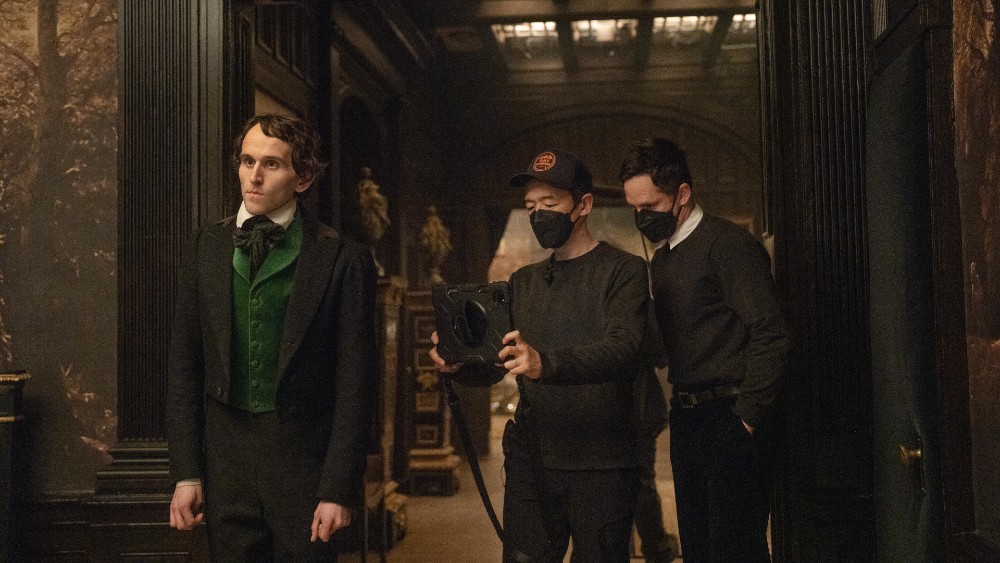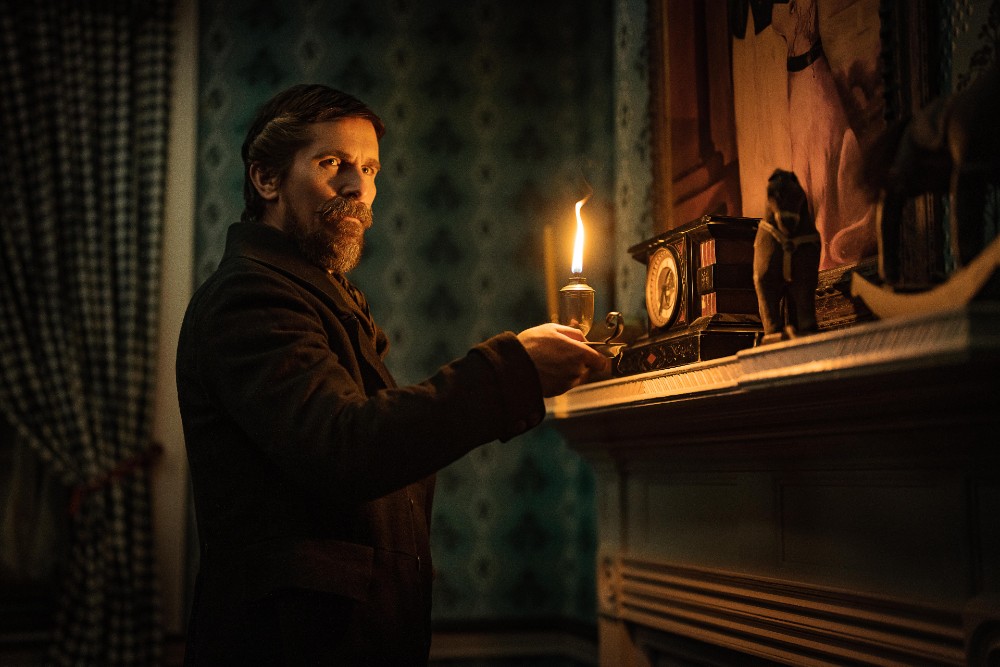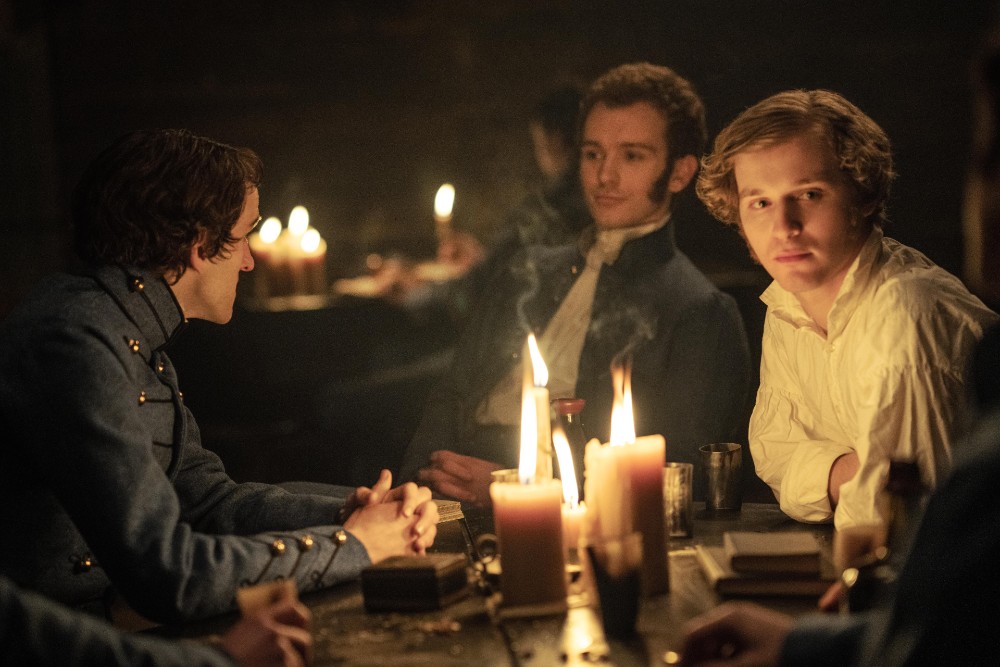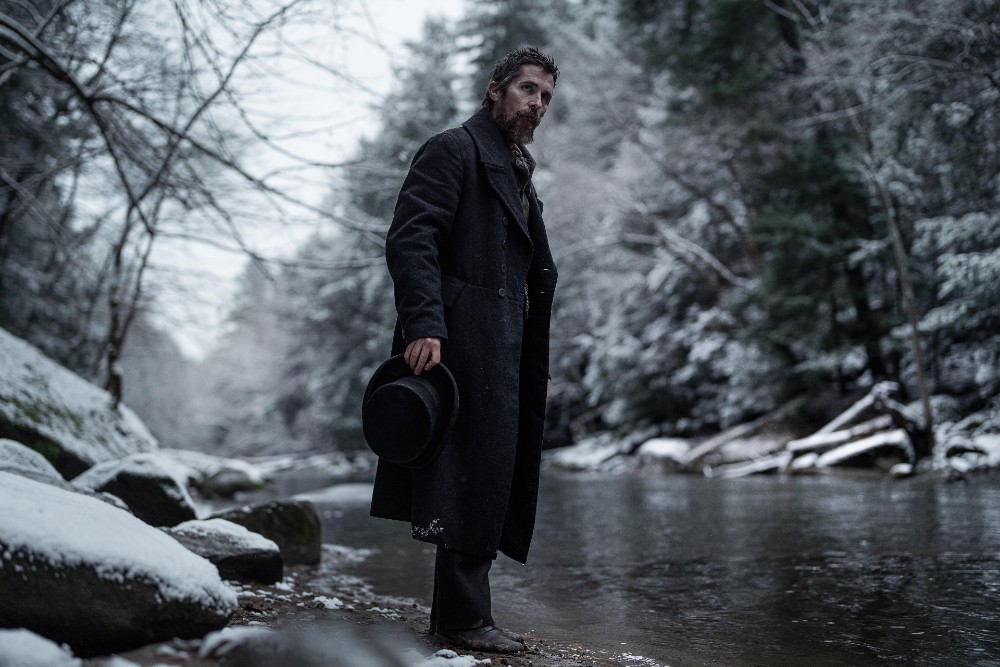Scott Cooper‘s latest film, the moody period piece The Pale Blue Eye, is an adaptation of Louis Bayard‘s novel about a series of grisly murders at the West Point military academy in upstate New York, and its distinctive look really helps enhance the mystery at the center of the story.
Set in the early 1800s, the Netflix film stars Christian Bale as detective Augustus Landor, who is called to investigate at West Point, where he enlists the aid of a clever young cadet by the name of Edgar Allan Poe (Harry Melling). The rest of the cast includes Gillian Anderson, Lucy Boynton, Charlie Tahan, Fred Hechinger, Harry Lawtey, Toby Jones, Timothy Spall, Simon McBurney, and Charlotte Gainsbourg.
The Pale Blue Eye marks the fourth collaboration between Cooper and his longtime DP, Masanobu Takayanagi, who shot the director’s previous films Out of the Furnace, Hostiles, and Black Mass, as well as Gavin O’Connor‘s Warrior, Joe Carnahan‘s The Grey, and David O. Russell‘s Silver Linings Playbook, and Tom McCarthy’s Best Picture winner Spotlight. He also received the American Society of Cinematographers‘ ASC Heritage Award in 2003, when he was still a student.
Below the Line jumped on the phone with Takayanagi to talk about the Japanese DP’s latest collaboration with Cooper and how he achieved the gorgeous, distinctive look of The Pale Blue Eye. You can also click here to read our earlier interview with Cooper on Above the Line.

Below the Line: I’m a big fan of your work with Scott, as well as with Tom McCarthy. Do you remember the first time you met Scott prior to working with him on Out of the Furnace?
Masanobu Takanayagi: The first time we met [was] in a café, somewhere in Brentwood. It was a long time ago. When was that, 2011? Wow, it’s more than 10 years ago… crazy.
BTL: Scott recently programmed Michael Cimino’s The Deer Hunter at my local theater, and I could definitely see the influence of that movie on Out of the Furnace.
Takanayagi: Yeah, we talked about [that] movie when we made it, and also, that movie was shot very close to where we were shooting. It might not have been Pittsburgh or that area. It may have been in Ohio somewhere, but I think one of the locations was close by.
BTL: Scott mentioned that The Pale Blue Eye is something he’s been working on for almost 10 years. Did he mention it to you back then, and did you see early drafts of the script over the years?
Takanayagi: No, the first time Scott told me about this movie, it was normal movie procedure, probably only a few months. Sorry, no, because we were gonna actually do [it] somewhere else. Originally, it was planned in [the] Philadelphia area during the summertime, and then Scott didn’t like the idea of the summer, because we didn’t think the movie went well with lush, green fields, so we waited, and then we changed the location to Pittsburgh, basically. So yeah, probably six months before we started shooting.
BTL: But that was the first time you heard about it?
Takanayagi: Yeah, I didn’t have any idea about this while we were doing some other movies, like Hostiles and Out of the Furnace. I didn’t know about [it].
BTL: When you first heard about it, did you go read the book as part of your research? Or did you just work off of Scott’s adaptation?
Takanayagi: I did not read the original book. If [a] script is based on any books, I try not to read the book. It’s funny you ask me that. I finally am currently reading the novel. I finally picked up the book and I’m going to read it. So far, so good. [laughs]
BTL: So you waited until the movie was completely finished to dive in?
Takanayagi: Yeah, I wanted to base everything on [the] script.

BTL: When you started scouting the movie with Scott and the production designer, what were some of the things you were looking for?
Takanayagi: We shot in western Pennsylvania. We discussed a lot with the Production Designer, Stefania [Cella], a very talented lady. The upper New York area where West Point is located has a very particular feel and geographic position, because of the Hudson River. That was definitely a discussion, choosing the location, and imagining we’d have a lot of VFX help also, so we were pre-imagining and previewing scenes in our head [of] how this was going to work. Geography was definitely a big part of it because it was such an iconic location, where West Point is located — back then and now, too, in the same place. Also, it’s not that we had a lot of locations, but it’s very period because it’s set in 1830, I think, so just being specific and right about the time period was also a big thing, and the art department did such a great job.
BTL: Did you actually go up to West Point with Scott? I know he went there for research.
Takanayagi: Stefania and Scott went there, [and] prop department, some of them, even [the] costume department might have been there. I wanted to go, but I didn’t have a chance to go. I kind of wanted to see the geographic position, but somebody also mentioned that they’re not sure if it helps, because it’s very different from back then. The river might be the same, but some of the buildings are completely different, of course. There’s a parking lot and all this, but anyway, I couldn’t find the time to go there.
BTL: Did you have pictures and things like that to work from, at least?
Takanayagi: Yeah, pictures and maps from back then, and all the research from the art department. [Again,] they did such a great job.
BTL: Did you have any visual or cinematic references for The Pale Blue Eye that Scott wanted you to take a look at prior to shooting?
Takanayagi: Scott and I usually don’t specifically like to nail down the look beforehand. We discuss a lot about the mood, emotion, and [the] story. The look of the movie definitely evolves throughout the process of our conversations, [and] also by nailing down the locations — that decides a lot of the look of it, too.
Having said that, some of the mood that I had in my head was [from Andrei] Tarkovsky‘s Polaroid book, a few frames from there — photos with mist and [a] really moody feel to [them]. Some of those images stuck [in] my head, and unconsciously, I might have used that — not [for] framing in a specific way, but just [in terms of] the emotion and the mood.
BTL: Are you and Scott doing a lot of storyboarding during pre-production, or do you really wait and rely on the locations when you’re there?
Takanayagi: The only part that we did a storyboard process was [for] the ice house, towards the end, when the ice house [catches on fire], and there’s a lot of action there. We storyboarded [that], but then we deviated from the storyboards quite a lot. It was a good process to go through because that way we had the base to go from there, so that was good. Most of the time, other than that, [there weren’t] storyboards for [the] entire movie, just that sequence.

BTL: Was there any sort of pre-vis as part of that process?
Takanayagi: The art department did some of the pre-vis [for] some of the sets and locations. Conceptual art was very helpful, based on Stefania’s ideas of buildings and structures and geography, and then some artists did some pre-visual conceptual art with mood — mist and fog. We probably only had a few frames going around, but that helped a lot just to feel the mood and be on the same page with everybody else.
BTL: I think Scott mentioned that all the snow was real, so how does that pose a challenge to you as a cinematographer? Snowfall is pretty impractical because it’s not like you can control where it goes or how it looks…
Takanayagi: This was not my first time with snow, because I’ve done a few snow movies, including The Grey up in Northern Canada. Snow just physically makes everything difficult, because it’s cold. The special effects department, physical effects, did a lot of work laying down the snow, and even crushed ice, like a snow machine. When we needed it to snow, they laid down the snow, and then visual effects also augmented here and there a little bit, too. But we definitely tried to be true to real snow as much as possible, and we got really lucky with the weather sometimes — like, the sky dumped some snow also, so that helped. Also, the First AD Chris [Surgent] and Scott, we discussed, ‘Okay, the snow is coming. Should we switch the dates?’ and that happened probably a couple of times. We might have switched [around] the dates ’cause of snow.
BTL: I understand you were shooting just as Omicron was starting, which is pretty crazy, but if you had to delay production then you might have had to wait another year to make it due to the weather.
Takanayagi: Yeah, that’s right. We kinda managed through it. Luckily, I don’t think we shifted. There was once, probably, [that] somebody had it, but there weren’t any major schedule changes because of that, so it was good.
BTL: The look of this movie is so key to its success, and it looks so different from the other three movies you’ve shot for Scott. Is any of that done during post during the coloring phase to keep everything consistent? Or do you try to achieve as much of that look in-camera while shooting?
Takanayagi: Good question. I have a great DI colorist, Tom Poole, at Company 3 in New York. We did some camera tests, probably a few weeks before we started shooting. We did some tests with candles, and I [shot some exteriors], and I took that footage to Tom in New York, and we graded together just to come up with a LUT for the camera. We’d play with it with Tom, and we came up with this LUT to help establish the look of it. That process helped a lot to [maintain] the look of the movie.
BTL: Are you shooting with analog at this point or still shooting digital? What kind of cameras are you using?
Takanayagi: It was digital. We used the Alexa Mini LF with lenses from Panavision. I think it was a T-series Panavision anamorphic.
BTL: Were you shooting someplace close to a rental shop in case you needed stuff like lenses? I got the impression you were in the middle of nowhere, more or less.
Takanayagi: Everything had to be shipped in from Panavision. I don’t know if it came from New York Panavision or [the] West Coast, but it came from Panavision.

BTL: You spoke briefly about visual effects, so did you work closely with the VFX department in post along with the colorist?
Takanayagi: Definitely. The Visual Effects Supervisor, Jake [Braver], we shared an office together so we [could] have conversations [and] they were a big help. Being a period piece, we definitely had to erase all these modern elements, like if you see a house in the background with some cables, that kind of removal. Also, the snow augmentation, definitely, [and] some of the set extensions. We couldn’t find a complete field for West Point, for example, so they expanded the size of the field. We found a soccer field but they needed to expand it more. They were a really great help. Without them, the movie [would’ve been] impossible, for sure. [laughs]
BTL: It sounds like you were able to start minimizing the limitations of the pandemic if you were able to share an office with the VFX Supe. And from a COVID standpoint, it probably helped that so much of this movie takes place outdoors.
Takanayagi: Yeah, we were definitely feeling the pressure of Omicron when we were shooting, for sure. We avoided going out on the weekend. I always stayed in my apartment and everybody was careful — they were all responsible. Process-wise on set, even for my communication with the colorist, it was all good. I wouldn’t say [it was] 100 percent normal, but it definitely was [more] normal than the movie I did before during COVID [Mahershala Ali‘s Apple TV+ movie Swan Song].
BTL: This may be a little random, but as a cinematographer, do you feel that camera operators are properly acknowledged in the film business? I’m not sure if you usually operate yourself or not…
Takanayagi: Not just the camera operator. I think everybody, even the other people in [the] camera department — second assistant, loader, camera PA. Everybody should get acknowledged. Sometimes I say to people, ‘Wouldn’t it be great if you watched a movie without any credits?’ I wonder if people’s perceptions [would] change, not knowing [who did what].
BTL: Or put all the below-the-line workers first in the credits, in large font, and then put the actors. But I don’t think they can do that…
Takanayagi: [laughs] Going back to your question, yeah, I think camera operators are [in] such an important position. I usually operate the camera by myself, but of course, I have additional cameras and Steadicam operators. We can’t make movies without all this great talent, so yeah, they really should be [more] appreciated, for sure.
The Pale Blue Eye is now streaming on Netflix.





